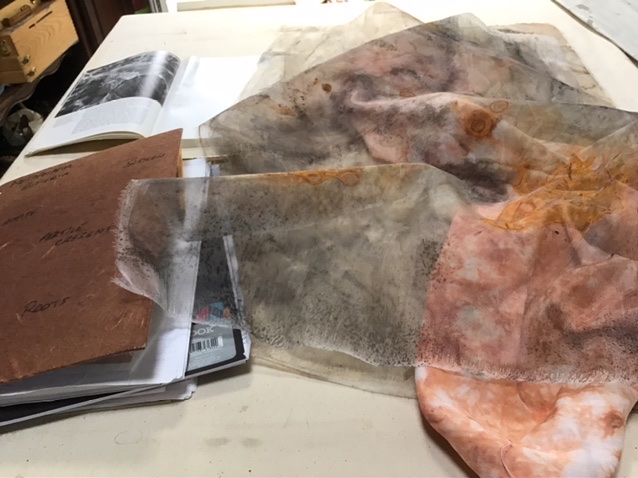I very often have Mesopotamia in the back of my mind when exploring with Studio 11 experiments - currently in how transparent fabrics can ben coloured and the potential they hold.
An assemblage is a group of objects brought together from a site which typify that site, or a particular period.
This is an assemblage of things old and new which may help me say something about Mesopotamia and history with textiles.
Most recently I created a stencil which which I used with a lamination technique to apply paper to some organza I had coloured as part of the transparent experiments we have been doing. The stencil was based the floor plans of several of the temple layouts at Eridu, the oldest of cities according to the Sumerians, where sweet water was discovered, site of the Abzu. The transparent is laid over some hand dyed fabric from an earlier class I took with Christine, sort of desert’ish. Though now I wonder if I should try something blue beneath it, for water. And whether I might not cut it up and use parts of it in different things, rather than as one piece.
The stenciling process - cutting out shapes from freezer paper and then ironing that paper onto the silk screen, has created all these negative shapes, which I shall keep and try to use in some other context.
I have been thinking about what skills were key to the development of civilisation in Mesopotamia, and one, of course, is weaving, without which we have neither baskets, nor linen shifts, nor tapestries. So I have been experimenting with the cordage technique, learnt on and Alice Fox workshop at Studio 11 using grass from the garden, fibres from yucca and phormium (New Zealand Flax), and some wool roving I bought, to create “thread” of sorts. The blue is the roving, twisted during a recent Studio 11 zoom session.
I like the way the colours work with this fabric, but the “thread” might also be useful with some of the other recent transparents experiments. Or perhaps I'll twist some more
The fabric is, again from an early workshop, using the wax resist technique to evoke the sort of patterns one finds in for example, pottery with scratched patterns, of rock carvings. Here assembled, to see how they might mingle with some linen thread I bought from “somewhere”.
And here, another assembled group of transparents - fine voile coloured with acrylic inks, walnut ink and rust dyed
They seem to fit together rather well
I at last have a stool workshop, so I can sit at my bench with music playing -
Heligoland in this case (Massive Attack one day Pergolesi the next!) - look at the anemones by the fence, and muse. It is a great pleasure. I am tucked away down the side of the house, and have to duck past the well to get here. It somehow feels appropriate












